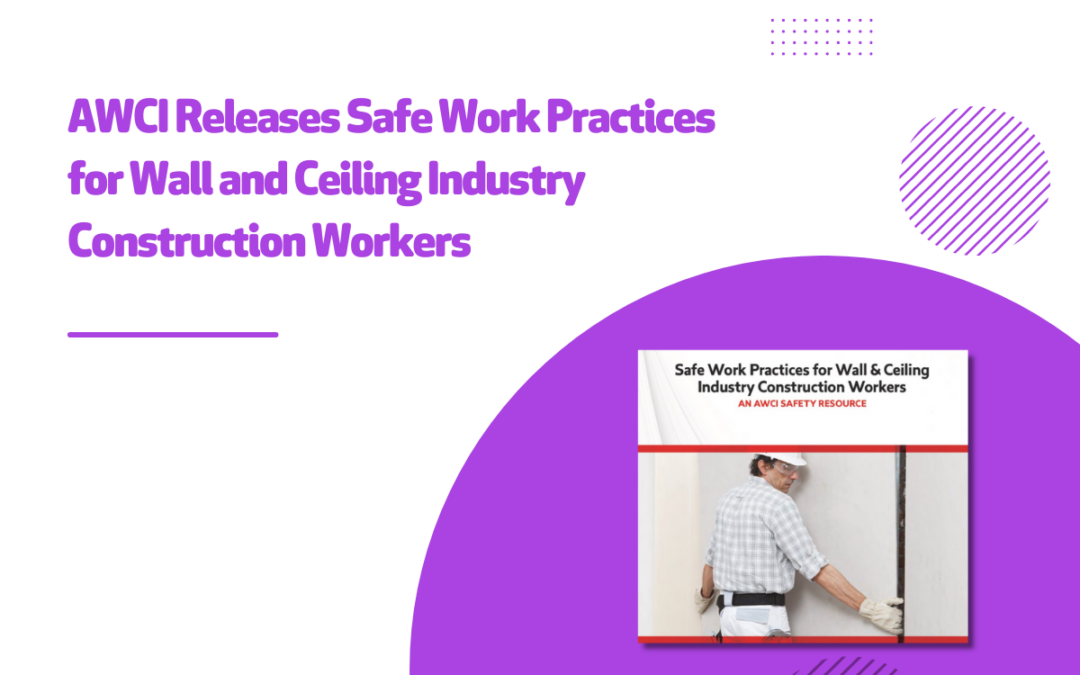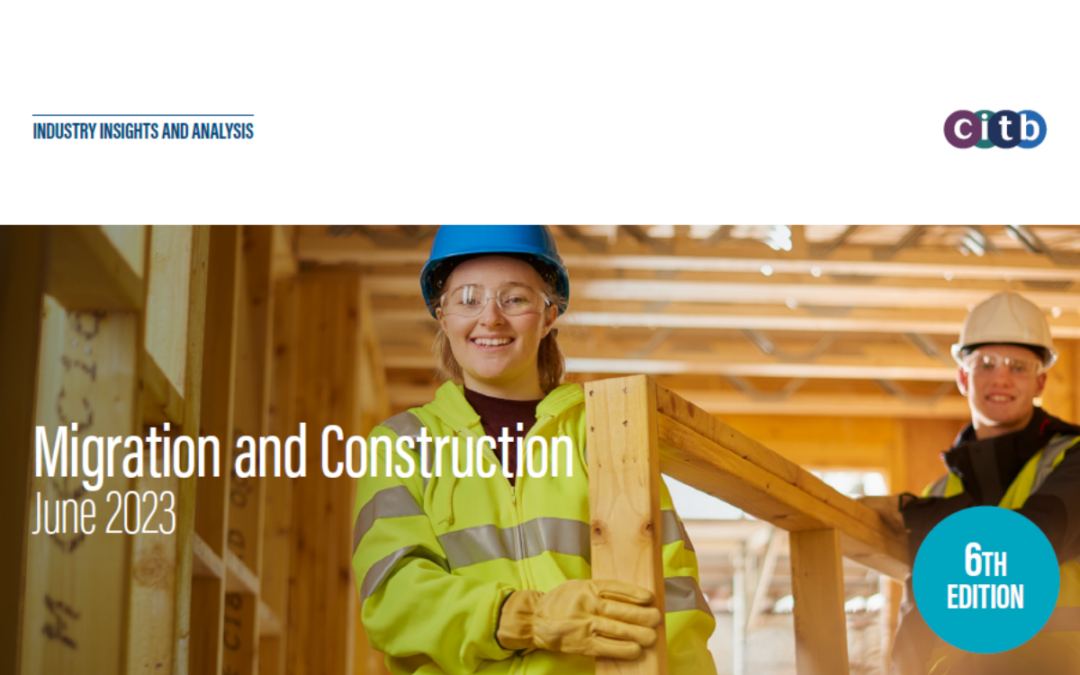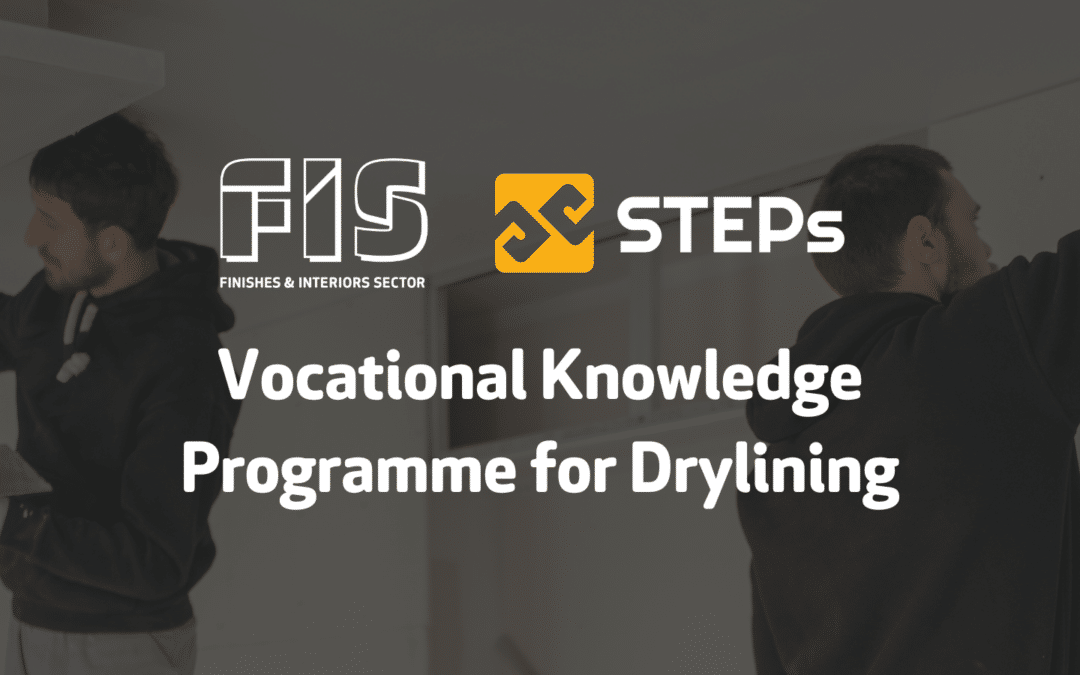
by Clair Mooney | Jul 7, 2023 | Health and Safety
AWCI has released “Safe Work Practices for Wall & Ceiling Industry Construction Workers, an AWCI Safety Resource,” a publication on best practices for construction site safety.
Targeted to construction professionals in the wall and ceiling industry, the 28-page document provides summaries of safety best practices and principles on 41 potential hazards in the drywall and plastering fields. The subject matter ranges from aerial lifts to welding and includes several topics specific to drywall construction, such as drywall carts and stilts.
FIS Chief Executive Iain McIlwee said:
“We enjoy a great relationship with the AWCI built on shared values and collaboration. We are grateful that we can bring this fabulous resource, developed in the US, to support safety in the UK”.
The information provided is a quick read and easy to understand, and is useful for toolbox-talk presentations as well as a year-round resource.

by Clair Mooney | Jul 4, 2023 | Market data, Material Shortages
The Department for Business and Trade is asking FIS Product Supplier members to respond to a short survey which is being conducted by their Global Supply Chains and Economic Security Directorate to identify businesses’ experiences of managing their critical supply chains and protecting against disruption.
The pandemic, as well as changes in the global economy, geopolitical environment and climate, have recently increased the frequency and magnitude of both demand and supply shocks to industry globally. Government and industry have worked closely on responding to this challenge over the past few years. Supply chain disruption continues to be a Government priority.
Through this survey, government is seeking to reach those who are responsible for trade and supply chain decisions within your business. All responses to the survey will be anonymised and any report produced will ensure that no individual respondents can be identified.
Click here to access the survey. It will be open until 17 July 2023.

by Clair Mooney | Jun 29, 2023 | Skills
The deadline for employers registered with CITB to submit their completed 2023 Levy Return is tomorrow (Friday 30 June). Failure to submit it on time will result in grant claims being withheld until it is received, and employers who do not submit a completed Levy Return by 30 November 2023 will lose eligibility for all grant claims.
More information is available at https://www.citb.co.uk/levy-grants-and-funding/citb-levy/levy-return/

by Clair Mooney | Jun 29, 2023 | Main News Feed
The CIJC has agreed new pay rates effective from Monday 10 July. There is a 6% increase in pay (8% for general operatives), as well as increases in travel and subsistence allowances and sick pay. There will be further increases from 1 January 2024 and the rates should be read in conjunction with the Working Rule Agreement and Holiday Entitlement 2023.

by Clair Mooney | Jun 29, 2023 | Main News Feed
Earlier this month, JCT announced that the next update to its suite of contracts will be the JCT 2024 Edition.
Digital working will continue to be a main feature of the JCT suite with JCT 2024, which will be published exclusively via JCT’s Construct subscription service, as well as On Demand digital and traditional hardcopy.
The main features of JCT 2024 include updates and changes corresponding with the following workstreams:
- Modernising and streamlining – including adoption of gender neutral language, and increased flexibility around the use of electronic notices.
- New for JCT 2024 – the introduction of a new contract family, JCT Target Cost Contract (TCC), comprising main contract, sub-contract, and guide.
- Legislative changes – major updates in relation to the Building Safety Act, Termination accounting and payment provisions reflecting the Construction Act, new insolvency grounds reflecting the Corporate Insolvency and Governance Act 2020.
- Future proofing – including changes to reflect the objectives of the Construction Playbook, and the incorporation of previously optional supplemental provisions relating to Collaborative Working, and Sustainable Development and Environmental Considerations, into the main document.
More information is available here

by Clair Mooney | Jun 29, 2023 | Building Safety Act
The Department for Levelling Up, Housing and Communities has issued guidance which relates to the legal criteria for determining whether a building is considered a higher-risk building under the Building Safety Act 2022 and the Higher-Risk Buildings (Descriptions and Supplementary Provisions) Regulations 2023. It relates to the definition of higher-risk building during the occupation phase of the higher-risk regime only.
This guidance sets out the criteria for a building to be a higher-risk building during the occupation phase of the higher-risk regime. Higher-risk buildings are subject to the requirements of the new higher-risk regime directly overseen by the Building Safety Regulator (the Regulator).
Higher-risk buildings, for the in-occupation requirements under Part 4 of the Building Safety Act 2022 (the Act), are defined in section 65 of the Act and the Higher-Risk Buildings (Descriptions and Supplementary Provisions) Regulations 2023 (the Regulations).
The obligations in Part 4 of the Act largely apply to occupied buildings and this is, therefore, referred to as the ‘in-occupation’ part of the regime. To understand whether a building is a higher-risk building, the Act and the Regulations need to be considered together.
For the in-occupation part of the regime, higher-risk buildings are defined as buildings with at least two residential units which are at least 18 metres in height or have at least seven storeys. The definition of “higher-risk building” is only for the purpose of the new higher-risk regime. The definitions in the Act and Regulations do not amend definitions in other legislation or definitions of building in other parts of the Act, such as the definition of “relevant building” under section 117 of the Act which defines a ‘relevant building’ for the purpose of the leaseholder protections under sections 119 to 125 and Schedule 8 of the Act.
This guidance document includes the relevant text from the Act and Regulations with explanations and diagrams. It is a tool to help potential principal accountable persons and accountable persons determine if the building they are responsible for is a higher-risk building. This guidance and the specifics and circumstances of your building need to be considered by you when discharging your duties under the Act and the Regulations. Diagrams in this guidance document show examples of potential buildings and are for illustrative purposes only. You will need to consider the legislation carefully to understand whether you are responsible for a higher-risk building in scope of the higher-risk regime. You may wish to seek legal advice on this.
In addition to becoming a higher-risk building under the Act and the Regulations, your building may also be subject to other legislation and statutory duties, such as the Regulatory Reform (Fire Safety) Order 2005. You will need to work with the relevant dutyholders in the building to ensure it is safe.

by Clair Mooney | Jun 28, 2023 | Main News Feed
Television presenter and award-winning designer Anna Campbell-Jones will be the star guest at this year’s Green Home Festival, which is again being organised by the Construction Industry Collective Voice (CICV), of which FIS is a key member.
The co-host and judge of hit BBC Scotland show Scotland’s Home of the Year will be a guest speaker at the second week-long event, which starts in 50 days as part of the official Edinburgh Festival Fringe.
Anna will discuss low-carbon living as part of the Ingredients for a Greener Kitchen show on the first day of the free festival, which will host 11 in-person and virtual sessions from 14-18 August to help consumers on the journey to net zero.
The interior designer – who won Scottish Influencer of the Year last October – said:
“I am delighted to be taking part in this year’s Green Home Festival and to be able to help raise the profile of eco-friendly living for consumers across Scotland.
“Finding greener ways of designing, decorating and renewing our homes will be vital for us all going forward and creating more low-carbon kitchens will be a key part of that.
“In particular, I feel passionately that the era of ‘fast fashion’ for interiors must come to an end. Kitchens are a significant contributor to unrecyclable landfill and I’m going to talk about alternative approaches to the concept of what we mean by ‘getting a new kitchen’.”
Anna starred in the grand finale of Scotland’s Home of the Year on Monday night (26 June), and also won the interiors and design award at the inaugural Scottish Influencer Awards in Glasgow in October 2022.
She will now star alongside experts from Scottish Water, plumbing body SNIPEF, electrical trade association SELECT and James Alan Construction, who will all share their first-hand knowledge and advise on what to consider when planning and renovating a kitchen.
Festival co-organiser Gordon Nelson, Scotland Director of the Federation of Master Builders (FMB) said:
“We are delighted to welcome Anna to this year’s Green Home Festival and look forward to hearing her invaluable input and expertise on greener living.
“Like all our shows, Ingredients for a Greener Kitchen will deliver a wealth of practical advice, focusing on the vital areas that can make kitchens eco-friendly – water efficiency, electrical efficiency and sustainably sourced materials and units.”
Other Green Home Festival shows to be delivered during the week include green garden rooms and offices, making retrofit projects eco-friendly, the potential of microwave heating, converting churches, and how the home of the future will be powered.
The event will also include a dedicated heat pump day, with experts hosting two separate shows to advise on how to reduce bills, access grants and install the new technology, as well as the options for hybrid heating.
Plus the experts from Built Environment – Smarter Transformation will host an in-person show on the advantages of community heat networks and an online webinar that will advise what consumers can do to reduce both their energy consumption and energy bills.
Mr Nelson added: “With 50 days to go, and with all the events now confirmed, the second Green Home Festival is shaping up to be as big a success as last year’s inaugural event.
“With a strong focus on accessing funding and saving money, our experts will offer practical demonstrations of low-carbon technology that consumers can put into action as we move towards becoming a net zero nation.”
The Green Home Festival is the latest in a string of practical and constructive initiatives launched by the CICV since its creation as the Construction Industry Coronavirus (CICV) Forum in March 2020.
Made up of 28 trade associations, professional services bodies and companies, including FIS, it has maintained a steady supply of information and practical advice to the sector as well as carrying out surveys, producing animations and posters, hosting webinars and maintaining close dialogue with Scottish Government ministers.
- Tickets for all Green Home Festival events are free and can be reserved here. The series finale of Scotland’s Home of the Year can be viewed again here.

by Clair Mooney | Jun 27, 2023 | Skills
Low levels of awareness and engagement with the Points-Based System (PBS) post-Brexit continue to exacerbate existing skills shortages within the sector, according to the latest Migration and Construction report by the Construction Industry Training Board (CITB).
Only half of employers surveyed indicated that they were aware of the PBS. Only 7% of employers reported that they have signed up as a licensed sponsor.
But there are plans to work closely with industry to make employers more aware of the benefits and how to navigate the system.
Addressing any barriers preventing employers, particularly small and medium-sized enterprises (SMEs) accessing the scheme and benefitting from recent changes to the Shortage Occupation List would help enable employers to more easily recruit migrant workers in high-demand occupations.
This is the sixth report and the first since the end of the pandemic and the introduction of the Points-Based System in January 2021 when the UK formally left the EU.
The report’s other key findings include:
- The share of migrant workers in the construction workforce fell to 9.8% in 2021 (latest year data is available for) from 10.2% in 2020 and 10.7% in 2018.
- Even in the early stages of recovery from the pandemic, and despite modest growth in output, over half (55%) of employers indicated that they have faced recruitment difficulties over the past two years.
- Almost a quarter (23%) of firms reported that recruitment had been very difficult. These problems have been greatest for larger firms employing more than 100 people (76% of employers) and in London, South-East and East of England (62%).
- The industry needs to deliver on its commitment to grow and invest in its domestic workforce by tackling long-standing weaknesses in how it attracts, retains and develops its workers skills and capability by raising the levels, quality and relevance of training.
- However, the Government, Construction Leadership Council (CLC) and industry need to work together to raise employer understanding and awareness of the PBS and to make the system work better for construction to address some of the critical short-term skills needs that industry now faces.
The government has responded to evidence from CITB and CLC of the recruitment pressures on construction employers by widening the range of occupations covered by the Shortage of Occupation List (SOL) in the Spring Budget.
The Shortage Occupation List (SOL) points out which jobs are facing shortages and aims to make it easier to hire migrant workers in these occupations. An ongoing consultation into the SOL was launched by the Migration Advisory Committee (an independent body advising on immigration) in March.
CITB’s migration and construction research has been critical in helping industry and government understand the skills and migration challenge industry faces.
Partnership work between industry and government aims to create a dynamic migration solution post-Brexit.
To help relieve pressures on employers, the CLC, industry groups and CITB have developed an Industry Skills Plan and are working with the government to put a range of support in place.
But the CLC has called for more to be done.
James Butcher, Director of Policy at the National Federation of Master Builders (NFB) and Chair of the CLC’s Movement of People Working Group, said:
“It’s important that awareness issues and barriers to how employers use the PBS are overcome to access the Skilled Visa Route and benefits for occupations on SOL, as shown in the report.
“The recent Construction Skills Network report from CITB highlights a need to invest in and train the domestic workforce to meet skills gaps and futureproof the industry.
“But that will take time – and the pandemic has already worsened the recruitment challenges faced by employers, from SMEs to major firms.
“So, in order to respond to critical needs in the short to medium term, we need to have a dynamic migration system in place.
“This report lays that bare and identifies areas we can make meaningful improvements.”
“We will work closely with our partners in government and industry to make the changes that will open up opportunities for employers and help them to become more agile in their recruitment processes so they can meet demand.”
Marcus Bennett, Head of Industry Analysis and Forecasting at CITB said:
“At CITB our focus is on supporting employers to recruit, train and retain the workers needed to meet levels of demand both now and in the future.
“We need to make construction an attractive place for a greater diversity of people to work, by improving employment practices, flexibility and the way we recruit. We will continue to encourage new entrants into the industry through training and support, including our apprenticeship schemes and grants, to bolster our domestic workforce.”

by Clair Mooney | Jun 23, 2023 | Sustainability
Members of the FIS sustainability group have come together to respond to the Government consultation on addressing carbon leakage risk to support decarbonisation – see: Addressing carbon leakage risk to support decarbonisation
As part of its plan to measure and reduce carbon emissions, the Government is considering a range of potential policy measures which include a carbon border adjustment mechanism (CBAM), mandatory product standards (MPS) amongst other policy measures to help grow the market for low carbon products. They are also considering emissions reporting.
The main points raised by the FIS group is that the construction industry has been measuring embodied carbon emissions from products for decades. EPD are well established and recognised as a mean to measure the environmental impact of construction products. In addition, the industry has recognised for a long time that measuring the environmental impact of products should not be done on a per tonne basis, first because it is not an appropriate measure for all construction products, but also because construction products are part of a larger system to fulfil a performance, eg: strength, acoustic or thermal. Comparison of the impact of products should be done in the context of their use, at building or product system, and could be done against a functional unit.
The other aspect that has been covered in the consultation is that the system the Government puts in place should be in line with the EU approach since most products imported come from the EU and the EU is a major market for the export of construction products.
To find out more details of the FIS response to the consultation, contact Flavie Lowres at flavielowres@thefis.org

by Clair Mooney | Jun 23, 2023 | Health and Safety
in response to calls for a consistent framework for drug and alcohol testing across the industry, the CLC has shared Build UK’s template Drugs and Alcohol Policy.
Recognising that there are different legal limits across the nations and workplace environments, along with various ways of testing, the policy can be adopted by the whole construction supply chain to provide a consistent approach to the issue of drugs and alcohol, which will help the industry to eliminate unnecessary duplication and waste.
The template policy has been drafted so that companies can adopt it in its entirety or incorporate elements of it into their own policy to suit their business, and the June 2023 version has been updated with additional information on the consumption of alcohol as part of corporate hospitality for those companies that permit it

by Clair Mooney | Jun 23, 2023 | Membership
To help support its members and to provide protection before a formal contract is issued, the Finishes and Interiors Sector (FIS) has launched a Client Order and Guidance Note that reflects the legislative and regulatory landscape in recent times.
Developed by FIS with the support of expert legal advisors at law firm Anderson Strathern, the new Client Order and Guidance Note for use in Scotland, England and Wales, is based on common issues and concerns that members have raised and is backed up by expert helplines. These new contracts will support FIS members working directly for clients and include a new and fresh set of standard terms that offer a fair share of risk and reflect the latest legislative and regulatory changes.
In an environment where the standard contract has become a misnomer, these contracts provide a mechanism to measure and benchmark onerous clauses that may have been introduced and offer more reasonable alternatives. In recent procurement research conducted by FIS, only 11% of contractors are routinely working on unamended “standard” contracts.
It is more common than might reasonably be expected for companies in the sector to start on site in the absence of a formal contract – 20% of respondents to research by the University of Reading indicate that they are required to start on site without a formal signed contract most of the time. The client order and guidance note will therefore provide a framework to support better training of members into some of the risks that are routinely being buried in contracts.
“The Guidance in particular gives FIS members key parameters to run and manage the commercial end of construction projects. Working in conjunction with the excellent construction solicitors, Karyn Watt and Gillian Green from Anderson Strathern, gave us the platform to marry legal and commercial advice to FIS members,” said Len Bunton FRICS FCIArb Hon FRIAS, Bunton Consulting Partnership.
“It is essential, particularly in today’s complex and challenging market, that members are aware of the risks they are taking on when entering into contracts and do what they can to mitigate them. The provisions in the Client Order and the Guide are there to highlight risks and to give members guidance as to how to best manage them. In a sector where recent changes can often be difficult to manage, the Client Order aims to address the most common issues the members are currently encountering in a pro-active and commercial manner,” added Karyn Watt, Partner at Anderson Strathern.
Commenting on the launch of the Client Order and Guidance Note, Iain McIlwee, CEO, Finishes and Interiors Sector (FIS) said:
“Contracts sit firmly at the heart of risk management. Developing these, whilst it isn’t a panacea to all the problems raised in our report produced with the University of Reading, it does start to focus efforts on managing the risk associated with the significant changes in the commercial and legislative landscape. They also build upon recent Best Practice Guidance that we produced with the CICV and the great work of the Conflict Avoidance Process to help individuals to better understand how we can improve overall understanding and management of the contractualisation of risk.”
In addition to this new Client Order and Guidance Note, FIS members can access a range of services to support them in managing the complexities of contracting and supplying products into the construction market. This includes template contracts, guidance on standard terms, support in dealing with disputes and a raft of best practice advice.
For further information or for any questions and comments, please contact FIS at info@thefis.org or call 0121 707 0077.

by Clair Mooney | Jun 22, 2023 | Skills
Funding is available to support individuals achieving a Level 3 Diploma in the following qualifications:
Level 3 NVQ Diploma in Occupational Work Supervision (Construction)
Level 3 NVQ Diploma in Trowel Occupations(Construction)
Level 3 NVQ Diploma in Decorative Finishing – Painting and Decorating (Construction)
Level 3 NVQ Diploma in Wood Occupations (Construction)
Level 3 NVQ Diploma in Insulation and Building Treatments (Construction)
Candidates must be 19+ years old and resident in the Greater Manchester area. To be eligible the individual must not already hol da Level 3 Qualification
Don’t miss out on accessing this valuable funding. For more information contact Marie Flinter at FIS on 0121 707 0077 or email marieflinter@thefis.org

by Clair Mooney | Jun 22, 2023 | Skills
To ensure businesses don’t miss out on up to £50,000 of support, the deadline to apply for CITB’s Leadership and Management Development Fund for large businesses, has been extended to 31 July, 2023.
The Leadership and Management Development Fund for large businesses enables large construction companies (with over to 250 directly employed staff) to invest in developing the leadership, management or supervisory skills of their workforce.
Eligible businesses can access up to £50,000 to support a wide range of leadership and management development activities. These include external or in-house training programmes, recognised leadership qualifications, development of new content or improvements to existing bespoke leadership training resources.
All training or related activity must focus on the development of management, leadership, or supervisory skills. This should be aimed at those whose primary role is as a manager, leader, or supervisor, or someone being developed to step into that role in the near future.
Tim Balcon, CITB Chief Executive, said:
“The Leadership and Management Development Fund offers a flexible approach for large businesses to deliver training based on their specific needs.
“This could be to help improve an existing program, develop a new one, try a new delivery method, or repeat an existing training program to new cohorts.
“The fund is just one of the many ways that CITB helps support the construction industry to have a skilled, competent and inclusive workforce, now and in the future.”
Award-winning property maintenance company Novus Solutions are a recent recipient of CITB’s Leadership and Management funding.
Matt Pitt, People Director, Novus Solutions, said:
“Our strategy is to make Novus a great place to work and to enable our people to become a differentiator for our business. Our aim is to create an internal development pipeline for core roles, become great at attracting people and develop our employee offer across Inclusion and Wellbeing whilst equipping managers with the tools to succeed.
“The CITB grant will enable Novus to implement several leadership programmes to equip managers with the tools for today and tomorrow, with an ageing workforce and less people joining construction it is essential that we progress in this space. Key themes will include Inclusive leadership, people management best practice, resilience, mentoring and coaching.”

by Clair Mooney | Jun 16, 2023 | Drylining, Skills
FIS, in partnership with e-Aptitude, is proud to announce the launch of its FIS STEPs Vocational Knowledge Programme for Drylining. This specialised technical education programme, which was produced by e-Aptitude with support from FIS, has been designed to support training providers in delivering apprenticeships and Vocational Qualifications (VQs) and candidates in achieving their qualifications in Drylining.
Divided into multiple modules, this online training resource provides:
- Access to clear, concise and accessible knowledge training to support candidates’ practical experience.
- Delivers consistent and up-to-date knowledge training.
- Resource for delivery of guided learning in group theory sessions.
- The facility to set tasks for self-learning and test retention of material.
- Tracks and monitors progress of candidates throughout the programme.
- Statistics and reporting data for management of trainees.
FIS Chief Executive Iain McIlwee said:
This is a learning resource that will support consistent delivery of the knowledge elements of both the apprenticeship and in support of those working towards assessment for a vocational qualification. As we move into the new era of competence, the sector must have a more consistent approach to instilling knowledge in anyone joining our workforce and this is a vital step forward for competency in the drylining sector.
Steve Halcrow, director of e-Aptitude, added:
The STEPs team is proud to be partnering with FIS on a project that is so vital for the future of our sector. High quality, consistent knowledge information is a key part of the training for a drylining apprentice and will be a powerful tool for employers and Training Providers delivering there apprenticeship.
FIS promotion of drylining training and our collaboration on this e-learning program, is a major step forward for our industry.
For further information or for any questions please email contact@stepsdigitalfis.co.uk or contact FIS at info@thefis.org or call 0121 707 0077.

by Clair Mooney | Jun 15, 2023 | Building Safety Act
The lights are going out on fluorescents – so what should you do?
The UK Government plans to phase out of all types of fluorescent lamps under the Restriction of the use of Hazardous Substances (RoHS) directive by 2024.
For decades fluorescent lighting has been fundamental in illuminating installations such as offices, schools and factories. Throughout the years, these luminaires have evolved from the T12 fluorescent batten which incorporated switch start control gear, to the T8, T5 or Compact Fluorescent Lamp (CFL) which are controlled by a high frequency electronic ballast.
The improvement in technology regarding the starting and controlling of fluorescent lamps with electronic gear reduced the consumers electricity bills and reduced the amount of heat energy emitted by the “thicker” T12 style lamp.
However, the last ten years have seen the gradual replacement of the fluorescent luminaire with the more efficient Light Emitting Diode (LED) fitting. This will continue to be the case, as the UK Government has followed the European Union’s lead in recent years by implementing the RoHS legislation which has already seized the manufacture of the T12 type lamp and has a directive of stopping the production of the remaining styles of florescent lamps by 2024.
These lamps contain mercury gas, which has been banned in the manufacturing of products. However, an exemption was implemented for the production of the fluorescent lamp. These lamps will still be in circulation and available to purchase until the dates of September 2023 for the T8 and February 2024 for the T5 and CFLs, when the manufacturing of lamps will end.
Although the availability of the lamps may aid maintenance, manufacturers have slowed the production of electronic control gear and inverters as the demand for the LED luminaire has increased.
Specifiers, clients, duty holders and landlords etc should consider the above information when consulting with their electricians regarding the method of illumination that should be used in properties when existing fluorescent lighting is present, considering the problems that may arise for maintenance, in the future.
Source: https://select.org.uk/SELECT/Website/Professionals_News/2023/June/lights_going_out_fluorescents.aspx

by Clair Mooney | Jun 15, 2023 | Skills
The Department for Education (DfE) will imminently be announcing its scheduled review into the role and effectiveness of both the Construction Industry Training Board (CITB) and the Engineering Construction Industry Training Board (ECITB).
Last undertaken in 2017, the review will assess the extent to which each Arm’s Length Body (ALB) performs effectively and delivers services that meet the needs of industry. The review is a requirement set by the Cabinet Office for all public bodies to be reviewed periodically.
The review is part of a wider programme across government to ensure that ALBs remain effective into the future.
The review will consider the ongoing need for the Industry Training Boards (ITBs), the effectiveness of the levy process and how it is invested, so that they continue to deliver for the public and represent a responsible use of levy funds.
It will consider the ITBs’ operating models, governance, accountability models and impact.
CITB has said that it will work closely with the review team to make visible its present impact, and demonstrate its plans and industry collaboration to deliver skills and training for the challenges ahead.
The review will be led by an independent lead reviewer, Mark Farmer, CEO of Cast Consultancy. He will be supported by a team of civil servants from the DfE. The review will also access expertise from the respective industries that the ITBs support as well as from across Whitehall
The DfE will shortly announce a call for evidence from stakeholders on GOV.UK and would particularly welcome contributions from employers in scope of the existing CITB levy orders, as well as trade bodies and representative groups from the construction industry. The call for evidence will inform early recommendations to ministers in late summer.
The DfE will provide contact details for submissions of evidence in the near future.
FAQs
Why is the review of the CITB and ECITB taking place?
The review is a requirement set by the Cabinet Office for public bodies to be reviewed based on level of risk. It will assess the extent to which Arm’s Length Bodies (ALB) performs effectively and delivers services that meet the needs of industry. The last CITB review took place in 2017.
Who are the review team?
The review will be led by an independent lead reviewer, Mark Farmer, CEO of Cast Consultancy and co-chair of Constructing Excellence, supported by a small team within DfE.
How can we get involved in the review?
DfE will shortly be announcing a call for evidence from stakeholders on GOV.UK. DfE would particularly welcome contributions from employers in scope to CITB, as well as trade bodies and representative groups from the construction industry. The call for evidence will inform early recommendations to ministers in late summer.
The DfE will provide contact details for submissions of evidence in the near future.
What is the Review likely to consider?
The extent of the review will ultimately be decided by the Lead Reviewer, but this will be influenced by guidance provided by the Cabinet office. The overall purpose of an ALB review is to ensure there is still a need for the functions carried out by an ALB, that the ALB is the right vehicle to carry out those functions, to consider alternative approaches to deliver the functions, assess the impact the ALB has and to determine any ways of making the ALB more effective and efficient.
When will the outcome be announced?
A final report and recommendations are expected to be submitted to the Secretary of State for Education at the end of 2023. Ministers will then assess the recommendations and determine the Government’s response having taken CITB views on the recommendations into account.
Is this different to the Consensus process?
Yes. The ALB review is a fundamental review of the organisation, its impact and future need. Consensus on the other hand is a very specific process carried out (usually) every three years to assess the industry’s views on CITB’s (ECITB’s) proposals for raising Levy over the next three years and their plans for effective use of the Levy generated. The next CITB Consensus process is due to take place between February and April 2024.

by Clair Mooney | Jun 15, 2023 | Main News Feed
Following the issue of PPN 03/23 earlier this year, which allows public sector bodies to use the Common Assessment Standard in place of PAS 91, Build UK will be publishing an updated version of the Common Assessment Standard on 1 July 2023.
Version 3.2 will include minor updates to the question set and associated guidance to reflect further legislative changes post‐Brexit and to provide additional clarity for companies being certified.
The Common Assessment Standard is reviewed every year to ensure that it continues to meet the needs of the industry. It is anticipated that further changes may be required following the introduction of the Building Safety Act, which will be confirmed once the secondary legislation has been published later this year, and members can suggest other changes for inclusion in Version 4 by completing this online form.
FIS has aligned its own ongoing vetting process to the CAS. Commenting on this, FIS Technical Manager James Parlour said:
Much of what we do in membership vetting depends on the existing accreditations of contractors, which is often already considered through various pre-qualification questionnaires (PQQ). FIS is very keen to see more widespread adoption of mutual recognition in this environment and is pleased to support the common assessment standard and respect the work of our members by aligning our vetting criteria with it.

by Clair Mooney | Jun 15, 2023 | Material Shortages
Statement from John Newcomb, CEO of the Builders Merchants Federation and Peter Caplehorn, CEO of the Construction Products Association, co-chairs of the Construction Leadership Council’s Product Availability working group.
Further to last month’s statement, once again there is good availability of most building materials across the UK, with the exception of rock mineral insulation, which is now on allocation, but is expected to normalise soon with increased production capacity.
While there are also some reports that plasterboard and roof tiles are on allocation, these appear to be either localised issues or restricted to a limited number of manufacturers, so do not seem to be creating significant problems in any sector. In addition, no major availability issues have been cited around either electrical components or timber, which in previous months were proving problematic.
At a macro level, construction output has risen by 2.7% since the start of the year despite adverse weather and various other factors such as strike action. The main area of growth over the past quarter has come from the repair and maintenance sector, but the commercial and civil engineering sectors have seen improvements as well. The associated retail trade has started to pick up with the return of warmer weather.
In the infrastructure sector there have been few reports of material shortages, but materials inflation still plays a major part in increasing project costs. The end of the Help to Buy scheme and continued uncertainty over interest rates, and its impact on mortgage availability, is constraining housebuilding. The consensus for sector forecasts is that year on year demand will be down this year before picking up in in 2024. More broadly and with a general election looming in 2024, positive stimulus by government in any of these sectors may boost fortunes for the industry.
Overall, ONS figures show that materials prices rose 8.4% in the first four months of the year, with inflation levels slowing to 4.7% in April. Looking ahead, however, although many larger manufacturers of energy intensive products have begun hedging their energy contracts into 2024, the costs of those products will likely remain elevated compared to the levels seen before the outbreak of war in Ukraine.
We are also monitoring the impact of drought conditions – including higher prices and delays to deliveries – affecting key logistic routes and shipping volumes from Asia and China and through the Panama Canal – though no firm data is yet available.
We are also aware that, with the availability and cost of financing options increasingly limited, commercial behaviour is likely to harden putting pressure on lower tiers and SME companies reducing cash-flow capacity and making liquidity a greater challenge. With the number of administrations in the construction sector at a very high level, this is another area we will continue to monitor.
Due to summer holidays, the Product Availability Group will meet next in September. There will be no reports published in July or August.

by Clair Mooney | Jun 14, 2023 | Building Safety Act, Main News Feed
FIS is aware of a report raised through CROSS (Collaborative Reporting for Safer Structures UK) that highlights a potential gap in understanding around testing of fire-resistant glazed doors and screens. The particular issue concerns the construction of the threshold in the supporting construction and the incongruence with typical threshold constructions on sites with raised access floors.
The report can be viewed on the CROSS website HERE.
CROSS is a confidential reporting system which allows professionals working in the built environment to report on fire and structural safety issues. These are then published anonymously to share lessons learned, create positive change, and improve safety.

by Clair Mooney | Jun 14, 2023 | Main News Feed
FIS has compiled a questionnaire to support a consolidated construction response to the latest HMRC consultation on the Construction Industry Scheme (CIS).
It considers whether it would be appropriate to add VAT to the list of taxes HMRC must consider when undertaking the statutory compliance test for receiving or keeping Gross Payment Status (GPS). It seeks views on how adding VAT could be given effect and the consequences for those affected.
In addition, the consultation sets out two areas where stakeholders have told HMRC that the operation of the CIS is causing unnecessary administrative burdens: landlord/tenant payments; and multiple reporting requirements by some groups. It seeks views on the scope and impact of those burdens, and the government’s proposals for removing or reducing them.




















